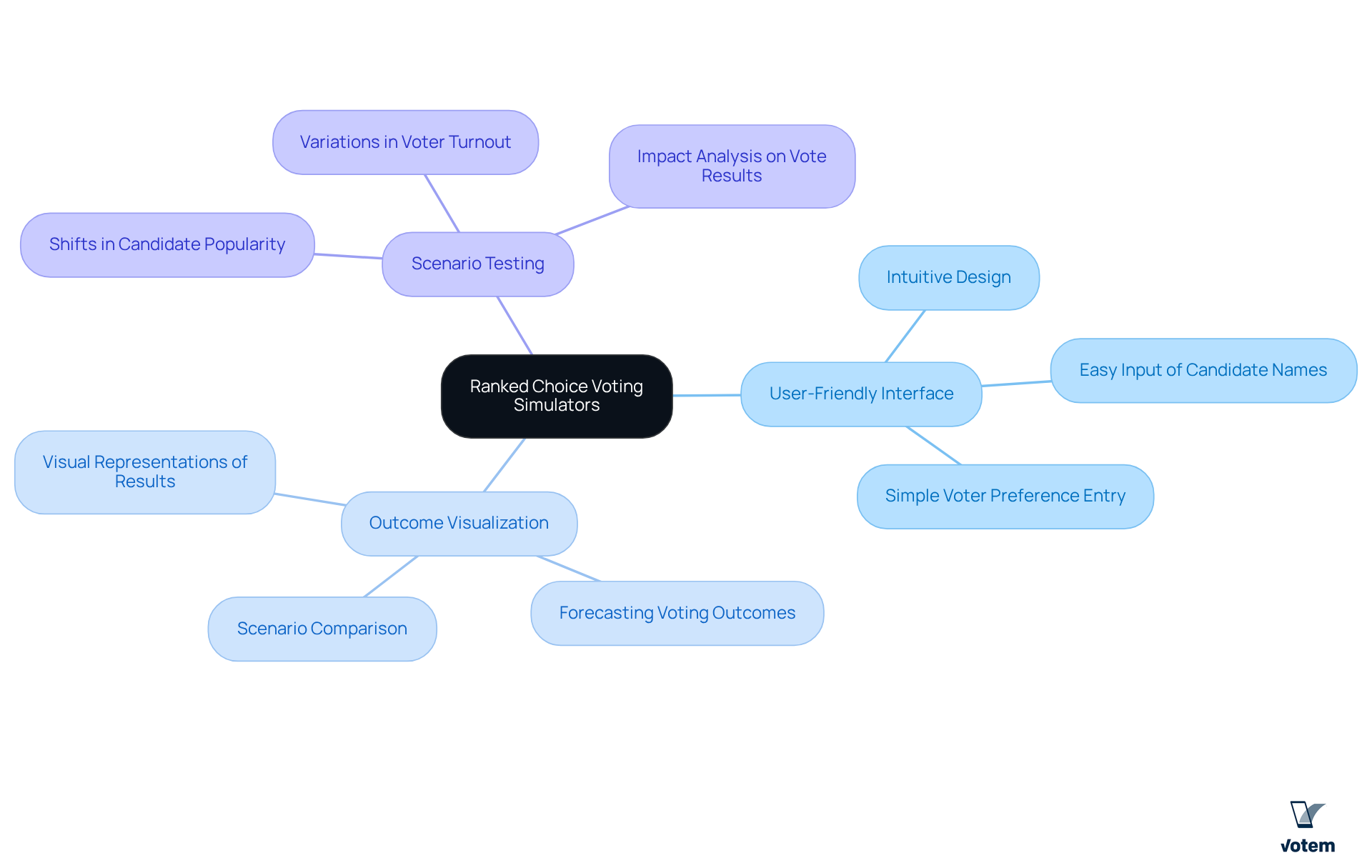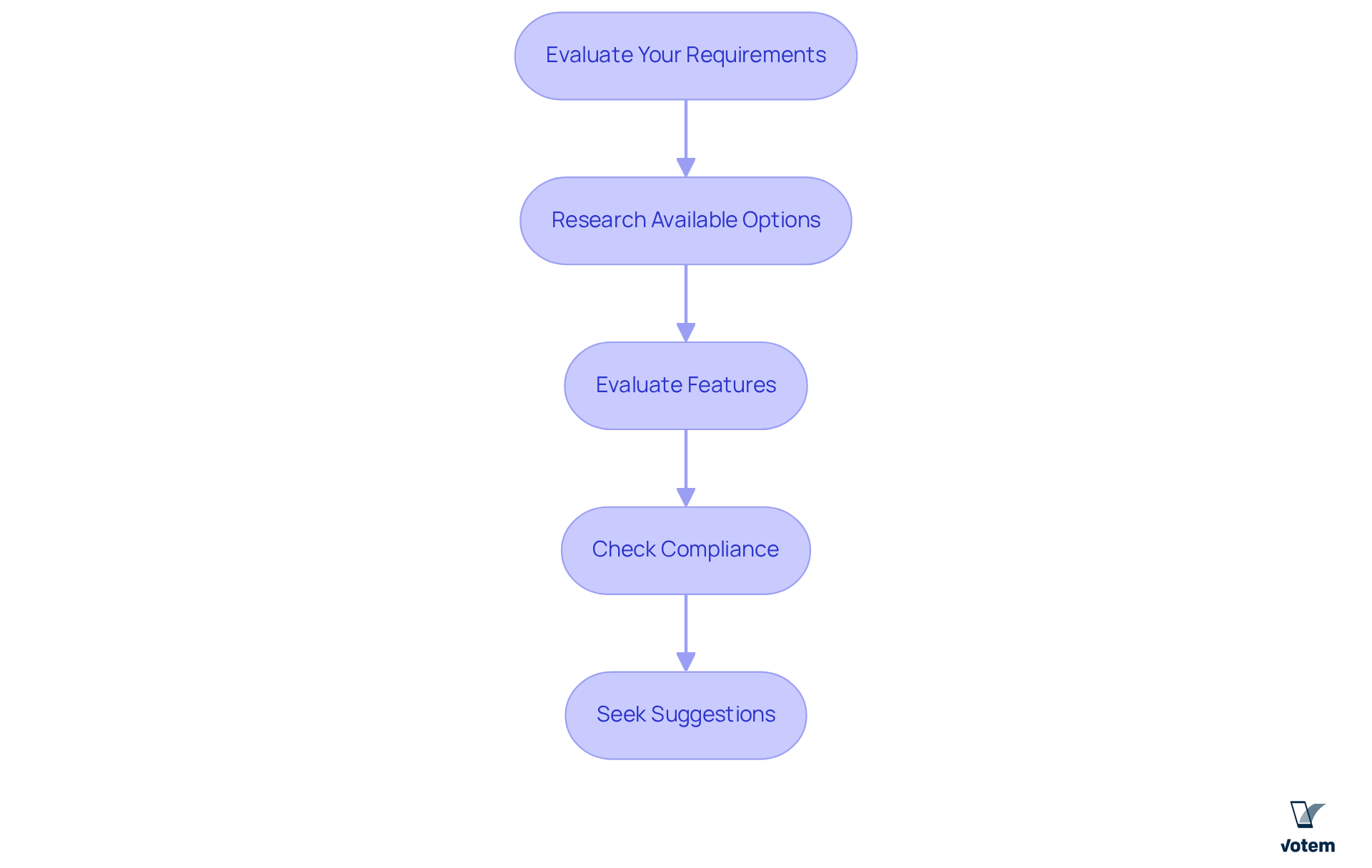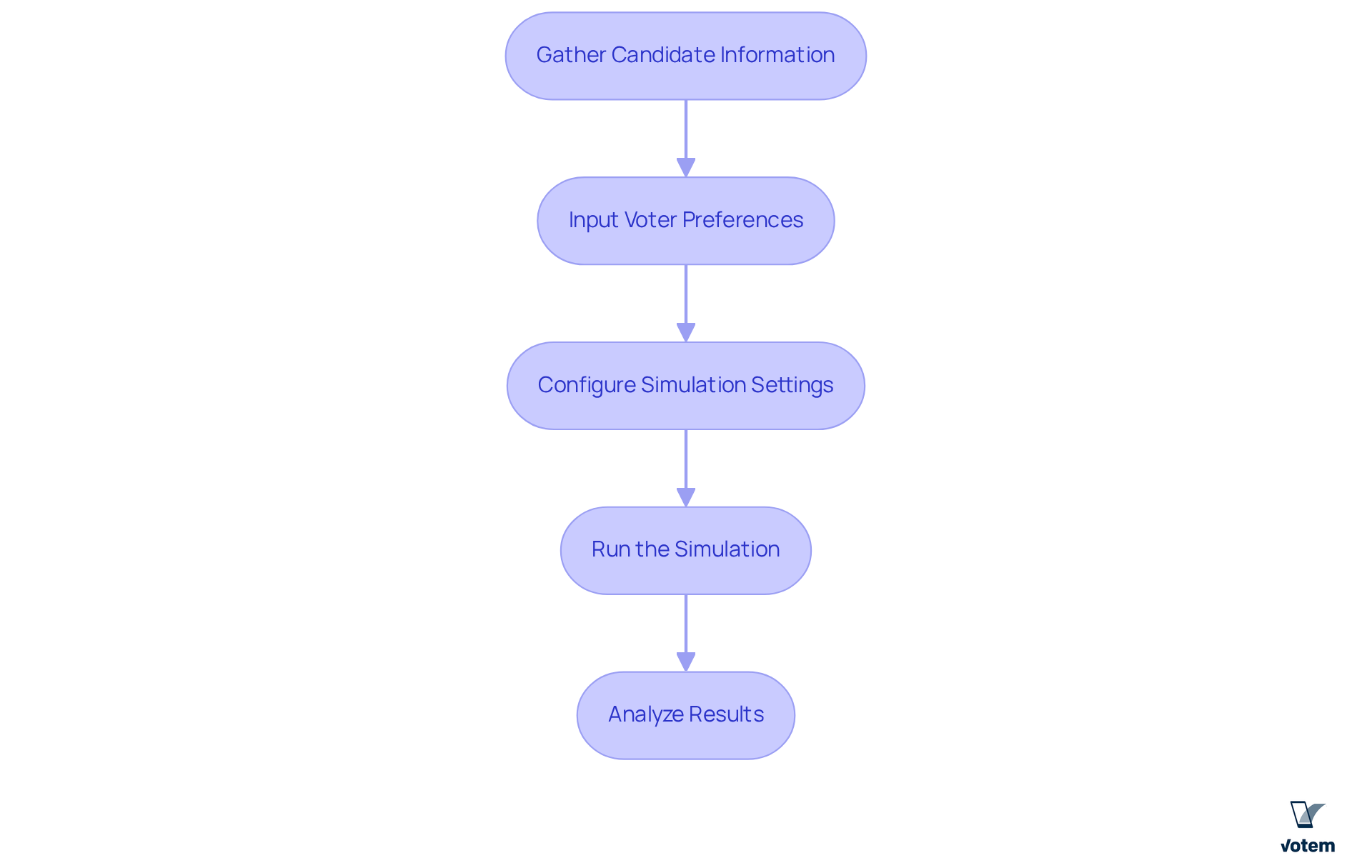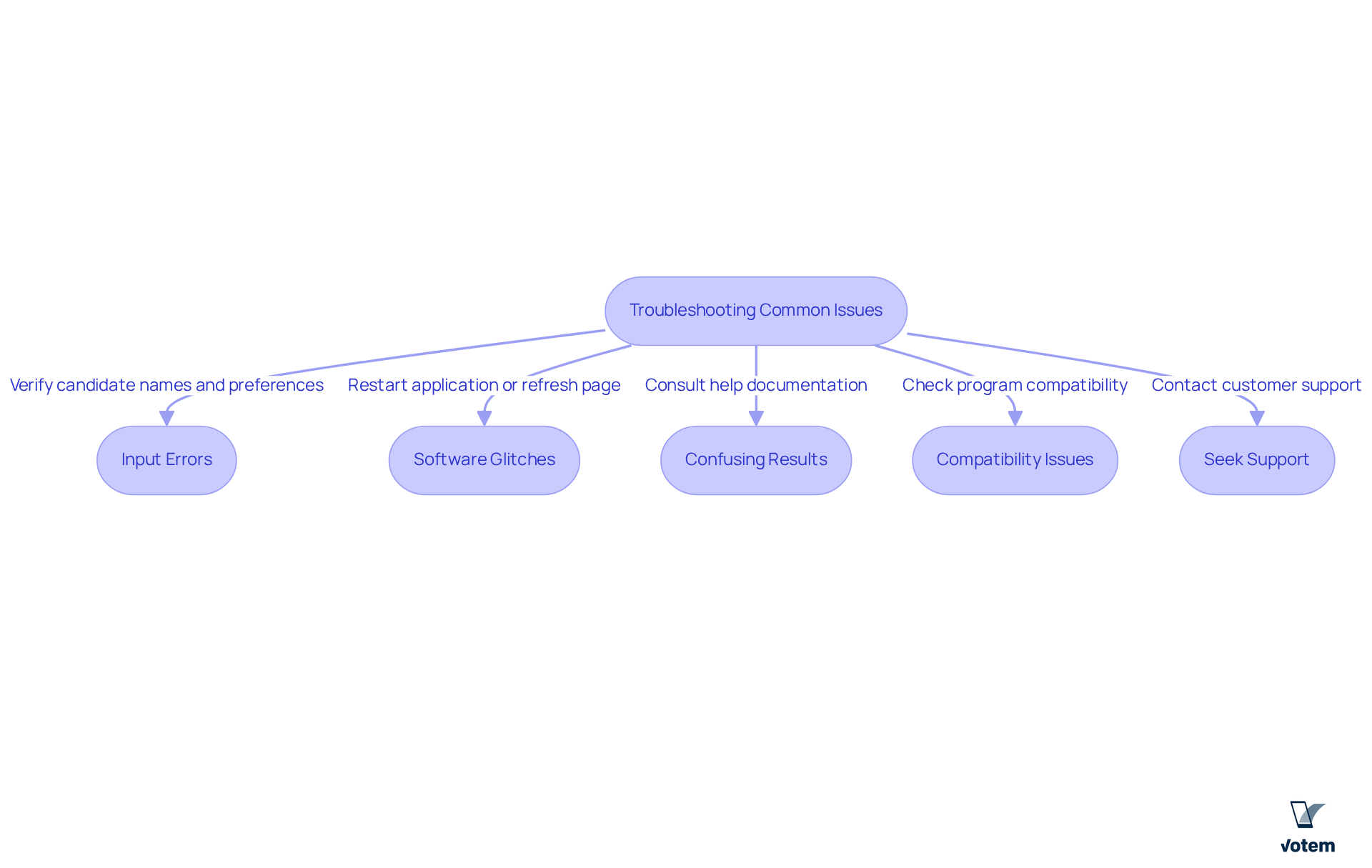Overview
The article examines how union leaders can leverage ranked choice voting (RCV) simulators effectively in elections, highlighting the necessity of comprehending their features and selecting the appropriate tool. By outlining essential considerations for choosing a simulator, such as:
- Assessing union needs
- Exploring available options
- Addressing common issues
it aims to enhance the electoral process and foster fair outcomes. Furthermore, understanding these elements not only empowers union leadership but also promotes a more equitable voting experience.
Introduction
Ranked choice voting signifies a transformative shift in electoral processes, particularly for unions aiming to bolster member engagement and representation. This innovative approach allows union leaders to utilize ranked choice voting simulators to explore various election scenarios, ensuring that every vote is counted and preferences are accurately represented. However, the challenge lies in selecting the appropriate simulator and effectively navigating potential pitfalls during simulations. How can union leaders master these tools not only to streamline their elections but also to cultivate a more democratic environment?
By embracing ranked choice voting, unions can enhance the electoral experience for their members. This method ensures that the voices of all participants are heard, fostering a sense of ownership and involvement in the decision-making process. Furthermore, the ability to simulate various election scenarios provides union leaders with valuable insights, enabling them to make informed choices that reflect the true preferences of their membership.
To harness the full potential of ranked choice voting simulators, union leaders must first identify the right tools that align with their specific needs. In addition, they should be aware of common pitfalls, such as misinterpreting simulation results or overlooking critical variables that could impact the election outcome. By proactively addressing these challenges, leaders can pave the way for a smoother electoral process that not only meets the needs of their members but also strengthens the democratic foundations of their unions.
Understand Ranked Choice Voting Simulators
Ranked choice voting simulators serve as essential tools for organizations aiming to model contest outcomes using ranked choice methods. Unlike conventional voting systems, Ranked Choice Voting (RCV) empowers individuals to rank candidates according to their preferences, often leading to more representative outcomes. Understanding the mechanics of these systems is vital for union leaders who seek to implement RCV in their electoral processes.
Key features of RCV simulators include:
- User-Friendly Interface: Most simulators are intuitively designed, enabling users to easily input candidate names and voter preferences.
- Outcome Visualization: These ranked choice voting simulators frequently provide visual representations of potential voting results across various scenarios, aiding unions in forecasting outcomes.
- Scenario Testing: Users can explore different scenarios, such as shifts in candidate popularity or variations in voter turnout, with the ranked choice voting simulator to analyze how these factors may influence the vote results.
By grasping these components, union leaders can make informed decisions about effectively leveraging RCV tools in their voting processes.

Select the Right Simulator for Your Union
Selecting the right ranked choice voting simulator for union elections necessitates careful consideration of several key factors:
-
Evaluate Your Requirements: Begin by determining the specific needs of your union, including the number of candidates, expected turnout, and the complexity of the process. Understanding these needs is crucial; research indicates that ranked choice voting (RCV) can lead to increased voter turnout by allowing voters to express their preferences more fully.
-
Research Available Options: Seek out tools specifically designed for union elections or those with a proven track record in similar contexts. For instance, cities like San Francisco and Minneapolis have successfully implemented RCV, showcasing its growing acceptance and effectiveness.
-
Evaluate Features: Look for user-friendly interfaces, customization capabilities, and the ability to simulate various voting scenarios. Prioritize tools that offer comprehensive support and documentation. Features that enhance user experience can significantly impact voter engagement, as RCV is known to encourage more civil campaigns and reduce negative campaigning.
-
Check Compliance: Confirm that the device complies with relevant labor laws and regulations, which is essential for maintaining the integrity of the voting process. Compliance ensures that the election is conducted fairly and transparently, vital for sustaining trust among union members.
-
Seek Suggestions: Connect with other unions or organizations that have utilized ranked choice election tools to gather insights and advice based on their experiences. Studying case analyses can provide important insights into the efficiency of various training tools.
By thoroughly assessing these factors, union leaders can select a ranked choice voting simulator that fulfills their electoral requirements and enhances the election experience. This ultimately results in more representative outcomes and increased satisfaction among participants.

Set Up and Run Your Simulation
To effectively set up and run your ranked choice voting simulation, follow these essential steps:
-
Gather Candidate Information: Begin by compiling a comprehensive list of candidates involved in the voting process, including their platforms and pertinent background details. This information is crucial for educating the public and fostering informed decision-making.
-
Input Voter Preferences: Next, input hypothetical voter preferences based on historical voting data or recent surveys conducted within the union. This step is vital to accurately reflect actual voting behavior and ensure the simulation’s relevance.
-
Configure Simulation Settings: Adjust the simulation parameters, such as the number of rounds, the method for eliminating candidates, and any specific rules applicable to your union’s voting process. This ensures alignment with your governance structure and enhances the simulation’s effectiveness.
-
Run the Simulation: Execute the simulation and observe the results. Most simulators will provide a detailed breakdown of vote counting and candidate elimination in each round, allowing for transparency and accountability in the process.
-
Analyze Results: Finally, review the outcomes to understand how various scenarios might influence the vote. Focus on any unexpected results or developing patterns, as these insights can inform strategic choices in actual voting processes.
By diligently following these steps, union leaders can effectively utilize the ranked choice voting simulator to prepare for their elections, thereby enhancing engagement and ensuring a fair electoral process.

Troubleshoot Common Issues During Simulation
Running a ranked choice voting simulator can present several challenges that require careful attention. Here’s how to troubleshoot common issues effectively:
-
Input Errors: It is essential to verify all candidate names and electoral preferences meticulously. Input inaccuracies can skew simulation results, leading to misleading outcomes. As Todd Donovan, Ph.D., emphasizes, voters must learn about multiple candidates; thus, accurate input is crucial to avoid confusion.
-
Software Glitches: In the event of a freeze or crash, promptly restart the application or refresh the page. Ensure that your device meets the necessary software requirements to guarantee optimal performance. Statistics reveal that a ranked choice voting simulator shows a candidate must receive 50% of the remaining votes to win, underscoring the importance of reliable software during simulations.
-
Confusing Results: If the results appear unclear, consult the system’s help documentation or support resources for guidance on accurately interpreting the data. Understanding the ranking process is vital to prevent ballot exhaustion, where a voter’s preferences may become irrelevant if all ranked candidates are eliminated.
-
Compatibility Issues: Verify that the program is compatible with your operating system and browser. If problems persist, switching to a different device or browser may resolve the issue. Additionally, consider whether your elections are partisan or nonpartisan, as this context can significantly impact the effectiveness of the simulation.
-
Seek Support: For ongoing difficulties, do not hesitate to contact the simulator’s customer support. They can provide tailored assistance for the specific challenges you are encountering.
By anticipating these common challenges and incorporating expert insights, union leaders can enhance their experience with a ranked choice voting simulator, ensuring a smoother and more effective process.

Conclusion
Mastering ranked choice voting simulators is essential for unions striving to enhance their electoral processes. By embracing these innovative tools, union leaders can guarantee fairer, more representative outcomes that genuinely reflect the preferences of their members. The implementation of ranked choice voting not only empowers voters but also cultivates a more civil and engaged electoral atmosphere.
This guide has explored key aspects of ranked choice voting simulators. From understanding their features to selecting the right tool, setting up simulations, and troubleshooting common issues, each step equips union leaders with the necessary knowledge to navigate the complexities of RCV. The emphasis on user-friendly interfaces, regulatory compliance, and scenario testing highlights the importance of preparation in achieving successful electoral outcomes.
As unions continue to seek ways to improve member participation and satisfaction, adopting ranked choice voting simulators presents a significant opportunity. By leveraging these tools, union leaders can drive engagement, promote transparency, and ultimately create a more democratic voting experience. Embracing this approach not only enhances the electoral process but also strengthens trust and unity within the union, paving the way for a more empowered membership.
Frequently Asked Questions
What is the purpose of ranked choice voting simulators?
Ranked choice voting simulators are tools that help organizations model contest outcomes using ranked choice methods, allowing individuals to rank candidates according to their preferences for more representative outcomes.
Why is it important for union leaders to understand ranked choice voting simulators?
It is vital for union leaders to understand these simulators to effectively implement ranked choice voting (RCV) in their electoral processes and make informed decisions.
What are some key features of ranked choice voting simulators?
Key features include a user-friendly interface for inputting candidate names and voter preferences, outcome visualization for forecasting results, and scenario testing to analyze the impact of factors like candidate popularity and voter turnout.
How do ranked choice voting simulators aid in forecasting outcomes?
They provide visual representations of potential voting results across various scenarios, helping users understand how different factors can influence the vote results.
Can users test different scenarios with ranked choice voting simulators?
Yes, users can explore different scenarios, such as shifts in candidate popularity or variations in voter turnout, to see how these changes may affect the voting outcomes.
List of Sources
- Select the Right Simulator for Your Union
- Ranked-Choice Voting – Center for Effective Government (https://effectivegov.uchicago.edu/primers/ranked-choice-voting)
- Set Up and Run Your Simulation
- RankedVote: Key Features (https://rankedvote.co/guides/using-rankedvote/key-features)
- Ranked choice voting “how to’s” – FairVote (https://fairvote.org/resources/ranked-choice-voting-how-tos)
- Does ranked choice Voting Increase voter turnout and mobilization? (https://sciencedirect.com/science/article/pii/S026137942400074X)
- How to Calculate Ranked-Choice Voting with SurveyMonkey and Microsoft Excel – RankedVote Guides (https://rankedvote.co/guides/applying-ranked-choice-voting/how-to-calculate-ranked-choice-voting-with-surveymonkey-and-microsoft-excel)
- Ranked Choice Voting in Practice: Implementation Considerations for Policymakers (https://ncsl.org/elections-and-campaigns/ranked-choice-voting-in-practice-implementation-considerations-for-policymakers)
- Troubleshoot Common Issues During Simulation
- Ranked choice voting – SciLine (https://sciline.org/elections/ranked-choice-voting-quotes)

